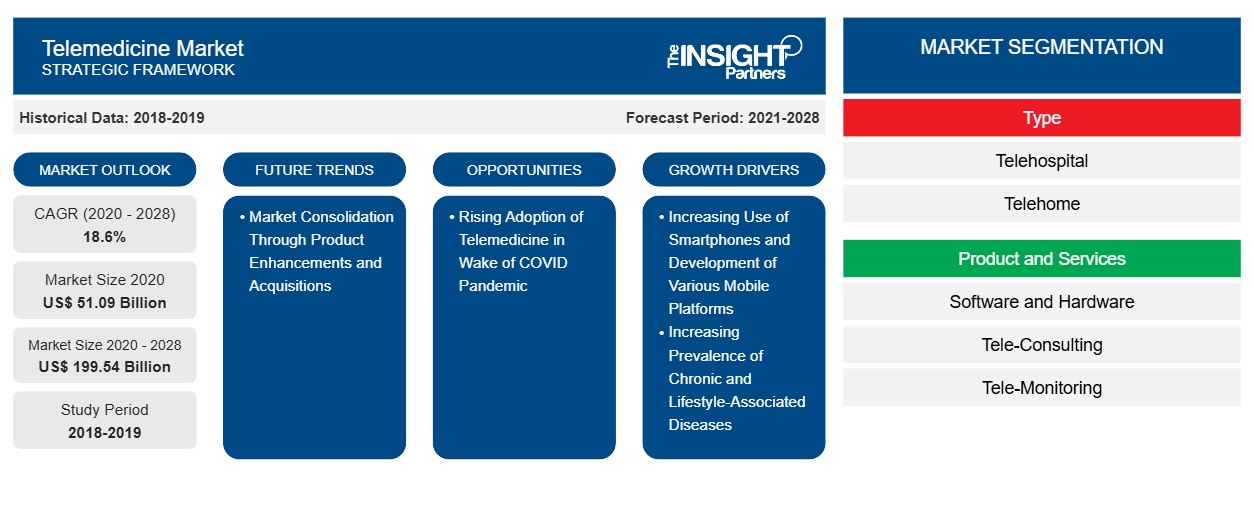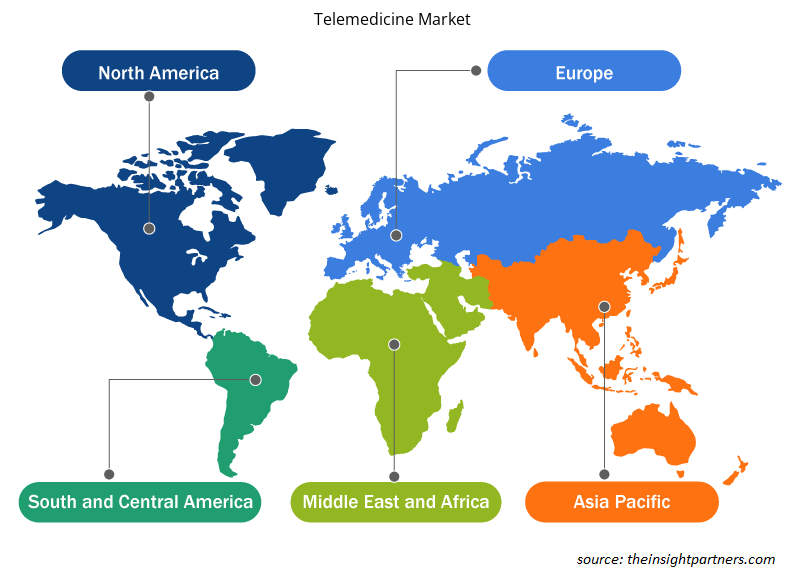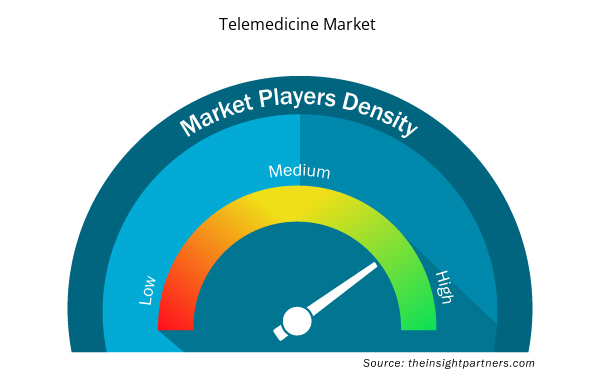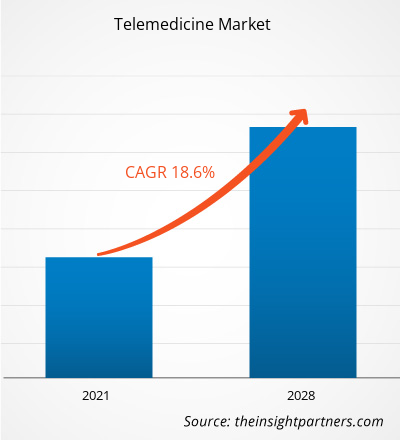[Research Report] The telemedicine market was valued at US$ 51,094.75 million in 2020 and is projected to reach US$ 199,544.64 million by 2028; it is expected to grow at a CAGR of 18.6% during 2021–2028.
Market Insights and Analyst View:
Telemedicine, a term coined in the 1970s, simply means healing at a distance. Telemedicine refers to the use of information and communication technology to enhance patient outcomes by increasing access to treatment and medical data. Telemedicine is a way to improve patient care and physician education. Increase in digitalization of healthcare services in developing countries such as India, China, Brazil, and Indonesia, and awareness about applications for telemedicine is fueling the growth of the telemedicine market. Also, increase in use of artificial intelligence, machine learning, and Internet of Things (IoT) to develop smart medications techniques is driving the telemedicine market growth.
Growth Drivers and Restraints:
Smartphones are making healthcare practices more comfortable and manageable as they play key role in the collection of patient’s health data; moreover, they can also act as a medium to provide healthcare services as well as to provide prescriptions, medical knowledge, recommendations, and so on. The telemedicine technology allows healthcare providers to support patients throughout disease surveillance, guidance treatments, and chronic disease management. The number of Internet users is currently rising at an annual rate of more than 7%, equating to an average of ~875,000 new users every day. However, the COVID-19 pandemic has had a big impact on internet user research, and hence, the actual figures are likely to be much higher. Moreover, according to Data Reporter Review, 42 published in February 2021, there were 5.11 billion unique mobile users worldwide in 2019, and 2.71 billion of them used smartphones. Additionally, 82.2% of the people in the UAE have a smartphone, which is the highest smartphone penetration in the world.
Tele homecare programs introduced in different countries include the Whole System Demonstrator (WSD) project in the UK, Veterans’ Health Segmentation (VHA) project in the US, and the TELEKART program in Denmark, among others. These tele homecare programs aim at assisting in reducing, managing, and preventing the occurrence of chronic diseases by remote monitoring of patients. In addition, in 2018, UNICEF developed RapidPro, a unique and innovative dashboard-system, to help the Malaria Sub-directorate of the Ministry of Health (MoH) in keeping track of health; the system is in effect since 2018, spanning 20 provinces and 20,000 villages. UNICEF is likely to continue to refine and expand the use of telemedicine tools to enhance the capabilities of communities and governments to manage HIV and malaria infections, awareness, immunization, and integrated national data as well as to ensure the long-term sustainability and scalability of the RapidPro program, as it is gradually being handed over to the government.
Customize This Report To Suit Your Requirement
You will get customization on any report - free of charge - including parts of this report, or country-level analysis, Excel Data pack, as well as avail great offers and discounts for start-ups & universities
Telemedicine Market: Strategic Insights

- Get Top Key Market Trends of this report.This FREE sample will include data analysis, ranging from market trends to estimates and forecasts.
Customize This Report To Suit Your Requirement
You will get customization on any report - free of charge - including parts of this report, or country-level analysis, Excel Data pack, as well as avail great offers and discounts for start-ups & universities
Telemedicine Market: Strategic Insights

- Get Top Key Market Trends of this report.This FREE sample will include data analysis, ranging from market trends to estimates and forecasts.
Report Segmentation and Scope:
The “Global Telemedicine Market” segmentation is done on the basis of product and services, type, specialty, delivery mode, and geography. Based on product and service, the telemedicine market is segmented into software and hardware, tele-consulting, tele-monitoring, and tele-education/training. Based on type, the telemedicine market is segmented into telehospital and telehome. Based on specialty, the telemedicine market is segmented cardiology, gynecology, orthopedics, neurology mental health (psychiatry) and others. Based on delivery mode, the telemedicine market is segmented into mobile, web, and call centers. The telemedicine market based on geography is segmented into North America (US, Canada, and Mexico), Europe (Germany, France, Italy, UK, Russia, and Rest of Europe), Asia Pacific (Australia, China, Japan, India, South Korea, and Rest of Asia Pacific), Middle East & Africa (South Africa, Saudi Arabia, UAE, and Rest of Middle East & Africa), and South & Central America (Brazil, Argentina, and Rest of South & Central America)
Segmental Analysis:
Based on product and service, the telemedicine market is segmented into software and hardware, tele-consulting, tele-monitoring, and tele-education/training. In 2020, the software and hardware segment held the largest telemedicine market share. However, the tele-consulting services segment is expected to grow at highest CAGR during the forecast period. Telemedicine hardware and software comprise the tools that are used to provide a mobile frame and storage system. Telemedicine hardware comprises the equipment that can be used in patients at home and in a clinical setting. For instance, blood pressure monitors, Bluetooth-enabled scales, and pulse oximetry monitors are used by specialists as well as consumers. Telemedicine cart is generally the most popular equipment which helps in a program running. This hardware is necessary to carry the camera, keyboard, computer monitors and mobile medical devices. With this help, physicians can move patient’s data room to room. Moreover, they can record and transmit a patient’s medical data.
Moreover, telemedicine software is used to save, transmit, or share the private health information of the patient from physician to physician or to direct patient. The software is friendly and secure, which provides free access for patients to deliver health care, health information, or health education at a distance through online service on mobile phones. Telehealth software is able to be executed in a variety of settings to abolish the need for special training as well as minimize downtime. Additionally, it helps in epidemiology & public health, electronic health records, personal wellness & fitness applications, clinical reference, and clinical decision support for patients.
Based on type, the telemedicine market is segmented into telehospital and telehome. In 2020, the telehospital segment held the largest market share of the telemedicine market, by type. However, the demand for telehome is also expected to grow at the fastest rate during the coming years. Tele-hospital includes sending reminder messages by voice or SMS to users via mobile health apps. The treatment services are aimed at achieving treatment passively, such as disease eradiation and overcoming challenges. It is applied to support patients with diabetes, HIV/AIDS, TB, and many more. Moreover, the treatment services also provide management for sleeping problems such as insomnia, depression, and anxiety, improving mental health. The tele-hospital helps deliver awareness regarding HIV prevention, chronic pain management, assisting in symptoms management of cancer, diabetes management. For instance, the FOCUS mobile app provided by the Center for Technology and Behavioral Health allows the users to track symptoms and receive targeted interventions based on responses to daily assessments. The increasing prevents of chronic diseases and rising need for patients' data management and to enhance the patients' care Tele-hospital segment is expected to grow remarkably.
Based on specialty, the telemedicine market is segmented cardiology, gynecology, orthopedics, neurology mental health (psychiatry) and others. In 2020, the mental health segment held considerable share of the market, by specialty. Psychiatry division of healthcare science is a specialty dedicated to various processes such as diagnosis, prevention, and treatment of mental disorders. IT may include different maladaptations associated with mood, behavior, cognition, and perceptions. Telepsychiatry is an emerging telemedicine specialty service that can provide a diverse range of services such as psychiatric evaluations, therapies such as individual therapy, group therapy, family therapy, patient education, medication management, and others. It facilitates direct interaction between psychiatrists and patients. With the help of video-based telepsychiatry, it's helpful to attend to the patients' needs for convenient, affordable, and readily accessible mental health services. It enables psychiatrists to treat more patients in distant locations and helps reduce patients' stress during the physical transportations from home to the clinics or hospital.
Based on delivery mode, the telemedicine market is segmented into mobile, web, and call centers. In 2020, the mobile segment held the largest share of the market, by delivery mode. Mobile telephone devices are an important component of the telemedicine system. Through the mobile device, the patients and the health care providers can communicate and exchange data. Smartphones are extensively used worldwide. The telemedicine applications and software can be operated and manage data. The mobile devices, through internet connections, patient data can be transfer and can be managed remotely. The developing internet penetration in developing countries is expected to support the growth of telemedicine markets.
Regional Analysis:
Based on geography, the telemedicine market segments into five key regions: North America, Europe, Asia Pacific, South & Central America, and Middle East & Africa. In 2020, North America telemedicine market held the largest share of the global telemedicine market, and Asia Pacific telemedicine market is estimated to register the highest CAGR during the forecast period. The US telemedicine market held the largest share in North American telemedicine market. In the United States, 76% of hospitals connect with patients using some form of telemedicine. With increasing need for a multidisciplinary approach to care and patient-provider partnerships, telemedicine has helped strengthen connections between patients, health care providers, and other stakeholders. In the face of the COVID-19 pandemic, the relevance of telemedicine has become even more acute. Use of telemedicine has been rapidly promoted, and laws on its coverage are rapidly changing. Though the use of telemedicine in the U.S. has been minimal prior to COVID-19, interest in and implementation of telemedicine has expanded rapidly during the crisis, as policymakers, insurers and health systems have looked for ways to deliver care to patients in their homes to limit transmission of the novel coronavirus. With growing demand for telemedicine, several changes have been made to telehealth policy, coverage, and implementation, in order to make telemedicine more widely accessible during this state of emergency. The federal government has focused on loosening restrictions on telemedicine in the Medicare program, including allowing beneficiaries from any geographic location to access services from their homes. HHS has waived enforcement of HIPAA for telemedicine, while the DEA has loosened requirements on e-prescribing of controlled substances. On a state level, many state governments have focused on expanding telemedicine in their Medicaid programs, as well relaxing state-level restrictions around provider licensing, online prescribing and written consent. Many states in the US are also mandating fully insured private plans to cover and reimburse for telemedicine services equally. Meanwhile, many commercial insurers have voluntarily addressed telemedicine in their response to COVID-19, focusing on reducing or eliminating cost sharing, broadening coverage of telemedicine and expanding in-network telemedicine providers. Health systems have rapidly adapted to implement new telehealth programs or ramp up existing ones.
The Asia Pacific region is expected to be the fastest-growing region among all other regions. The growth of the market in the Asia Pacific region is expected to grow at a faster pace owing to factors such as the growing prevalence of chronic disease in countries such as Australia, India, and others. Telemedicine market in India is expected to show a higher growth rate due to government policy that has ensured that standards have been set for EMR, medical records and standards, while on the other hand we see very large hospitals adopting digital in order to increase access and improve care outcomes. The Europe telemedicine market growth is attributed due to the Increasing Use of Smartphones and Development of Various Mobile Platforms and Increasing Prevalence of Chronic and Lifestyle-Associated Diseases. Also, rising adoption of telemedicine in awake of COVID Pandemic is likely to raise the demand for telemedicine. The Middle East & Africa telemedicine market is expected to grow due to rise in the prevalence of chronic diseases, and adoption of telemedicine’s by the developing economies. The South & Central America telemedicine market is expected to grow owing to rising adoptions of advance digital technologies for patient care in the region.
Industry Developments and Future Opportunities:
Various initiatives taken by key players operating in the global telemedicine market are listed below:
- In January 2021, Royal Philips expanded its leadership in patient care management solutions for the hospital with the acquisition of Capsule Technologies, Inc. Capsule’s Medical Device Information Platform - comprised of device integration, vital signs monitoring and clinical surveillance services - connects almost all existing medical devices and EMRs in hospitals through a vendor-neutral system.
- In December 2020, Philips to become a global leader in patient care management solutions for the hospital and the home through the acquisition of BioTelemetry, Inc. The acquisition of BioTelemetry is a strong fit with Philips’ cardiac care portfolio, and its strategy to transform the delivery of care along the health continuum with integrated solutions.
- In August 2020, Xealth and Cerner Corporation are working to improve the health care experience and empower patients to be active participants in their treatment and well-being. As part of this agreement, Cerner and LRVHealth have together invested $6 million in Xealth. The Xealth platform is designed to help clinicians easily integrate, prescribe and monitor digital health tools for patients from one location in the EHR.
- In July 2020, Teladoc Health, Inc., the world pioneer in virtual treatment, reported today that it has completed its acquisition of InTouch Health, headquartered in Santa Barbara, Calif. Teladoc Health will connect the clinical process through in-patient, hospital, and home care settings by integrating InTouch Health's advanced telehealth services that connect caregivers to one another in diverse medical environments. This will ensure increased access to high-quality care and improved health results.
Telemedicine Market Regional Insights
Telemedicine Market Regional Insights
The regional trends and factors influencing the Telemedicine Market throughout the forecast period have been thoroughly explained by the analysts at Insight Partners. This section also discusses Telemedicine Market segments and geography across North America, Europe, Asia Pacific, Middle East and Africa, and South and Central America.

- Get the Regional Specific Data for Telemedicine Market
Telemedicine Market Report Scope
| Report Attribute | Details |
|---|---|
| Market size in 2020 | US$ 51.09 Billion |
| Market Size by 2028 | US$ 199.54 Billion |
| Global CAGR (2020 - 2028) | 18.6% |
| Historical Data | 2018-2019 |
| Forecast period | 2021-2028 |
| Segments Covered |
By Type
|
| Regions and Countries Covered | North America
|
| Market leaders and key company profiles |
Telemedicine Market Players Density: Understanding Its Impact on Business Dynamics
The Telemedicine Market market is growing rapidly, driven by increasing end-user demand due to factors such as evolving consumer preferences, technological advancements, and greater awareness of the product's benefits. As demand rises, businesses are expanding their offerings, innovating to meet consumer needs, and capitalizing on emerging trends, which further fuels market growth.
Market players density refers to the distribution of firms or companies operating within a particular market or industry. It indicates how many competitors (market players) are present in a given market space relative to its size or total market value.
Major Companies operating in the Telemedicine Market are:
- Allscripts Healthcare Solutions, Inc.
- Amd Global Telemedicine, Inc.
- American Well Corporation
- Biotelemetry, Inc. (Philips)
- Teladoc Health
Disclaimer: The companies listed above are not ranked in any particular order.

- Get the Telemedicine Market top key players overview
Covid-19 Impact:
As the number of COVID-19–infected patients increased, population using computers and tablets for telemedicine also increased, which also reduced staff exposure in ambulances and hospitals. Telemedicine has experienced a huge surge in adoption over the past few months, during the coronavirus pandemic. With people locked down at home, it has become the 'new normal' way of accessing healthcare. It is expected that demand for these services increased dramatically globally in COVID-19 pandemic, as the shares of one telehealth provider, Teladoc Health Inc., increased almost 50% since the start of 2020. Hospitals and health systems also encouraged people with suspected COVID-19 symptoms to use telehealth services to limit people's flow to already crowded emergency rooms and doctor surgeries. Therefore, the growing demand for telemedicine during COVID-19 worldwide is likely to boost the growth of the telemedicine market.
Competitive Landscape and Key Companies:
Some of the telemedicine market leaders are Allscripts Healthcare, LLC, Cerner Corporation, Cisco Systems, Inc., Eagle Telemedicine, Honeywell International Inc., McKesson Corporation, Koninklijke Philips N.V. , AMD Global Telemedicine, Inc., American Well, Teladoc Health, Inc., and Insight. These companies focus on new product launches and geographical expansions to meet the growing consumer demand worldwide and increase their product range in specialty portfolios. They have a widespread global presence, which provides them to serve a large set of customers and subsequently increases their market share. The report offers trend analysis of the telemedicine market emphasizing on various parameters such as technological advancements, market dynamics, and competitive landscape analysis of leading market players across the globe.
- Historical Analysis (2 Years), Base Year, Forecast (7 Years) with CAGR
- PEST and SWOT Analysis
- Market Size Value / Volume - Global, Regional, Country
- Industry and Competitive Landscape
- Excel Dataset


- Oxy-fuel Combustion Technology Market
- Digital Pathology Market
- Photo Editing Software Market
- Malaria Treatment Market
- 3D Mapping and Modelling Market
- UV Curing System Market
- Analog-to-Digital Converter Market
- Print Management Software Market
- Bioremediation Technology and Services Market
- Rugged Phones Market

Report Coverage
Revenue forecast, Company Analysis, Industry landscape, Growth factors, and Trends

Segment Covered
Type ; Product and Services ; Specialty ; Delivery Mode ; and Geography

Regional Scope
North America, Europe, Asia Pacific, Middle East & Africa, South & Central America

Country Scope
Argentina, Australia, Brazil, Canada, China, France, Germany, India, Italy, Japan, Mexico, Saudi Arabia, South Africa, South Korea, Spain, United Arab Emirates, United Kingdom, United States
Trends and growth analysis reports related to Technology, Media and Telecommunications : READ MORE..
The List of Companies - Telemedicine Market
- Allscripts Healthcare Solutions, Inc.
- Amd Global Telemedicine, Inc.
- American Well Corporation
- Biotelemetry, Inc. (Philips)
- Teladoc Health
- Cerner Corporation
- Cisco Systems, Inc.
- Eagle Telemedicine Solutions Llc
- Insight
- Koninklijke Philips N.V
- McKesson Corporation

 Get Free Sample For
Get Free Sample For